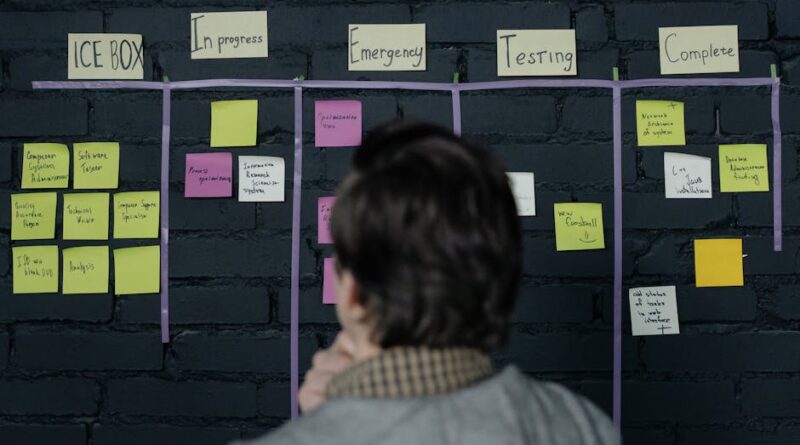Improving Product Management with Agile Techniques
Have you ever wondered how top companies launch products so quickly and effectively? The secret often lies in Agile techniques. These methods can transform how product managers work, making their teams more efficient and responsive. Lets explore how you can use Agile to enhance your product management skills.
What is Agile?

Agile is a way of working that helps teams be more flexible and collaborative. Instead of sticking to a strict plan, Agile encourages teams to adapt to changes quickly. Think of it like cooking a new recipe. If you taste as you go, you can adjust ingredients to make it better. that’s the essence of Agile.
According to the Project Management Institute, Agile projects are 28% more successful than traditional projects. This statistic shows the power of adopting Agile methods.
Why Use Agile in Product Management?

Using Agile in product management has many benefits. Here are a few key reasons:
- Faster Delivery: Agile breaks projects into small parts, allowing for quicker releases.
- Better Collaboration: Teams work together more closely, improving communication.
- Increased Flexibility: Agile allows teams to pivot and make changes based on feedback.
These advantages can make a huge difference in your products success.
How Can You Implement Agile Techniques?

Ready to dive into Agile? Here are some practical steps to get started:
1. Start with Scrum
Scrum is one of the most popular Agile frameworks. It divides work into short sprints, typically lasting two to four weeks. At the beginning of each sprint, the team picks a set of tasks to complete. This keeps everyone focused and accountable.
To illustrate, imagine a team creating a new app feature. Instead of aiming to finish everything at once, they focus on delivering one small, functional part in each sprint.
2. Hold Daily Stand-ups
Daily stand-ups are short meetings where team members share updates. Each person quickly answers three questions:
- What did you accomplish yesterday?
- What will you work on today?
- What obstacles are you facing?
This keeps everyone in the loop and helps identify problems early. it’s like a morning huddle before a game; everyone knows the game plan.
3. Prioritize with a Backlog
A backlog is a list of tasks that need to be completed. Prioritizing tasks helps teams focus on what’s most important. Product managers often work with stakeholders to decide which features or improvements should be done first.
For example, if users frequently request a specific update, it should be high on the backlog list. This ensures that the product evolves based on actual user needs.
What Are User Stories?

User stories are short descriptions of a feature from the perspective of the end-user. They help teams understand what users want. A simple format for user stories is:
As a [type of user], I want [goal] so that [reason].
For instance, As a frequent traveler, I want to book flights easily so that I can save time. This clarity helps teams focus on delivering real value.
How to Gather Feedback Effectively?
Feedback is crucial in Agile. It helps teams make informed decisions about what to change or improve. Here are a few effective ways to gather feedback:
- User Testing: Invite real users to test your product and provide input.
- Surveys: Send out brief surveys to gather opinions on specific features.
- Iterate: Use the feedback to make changes, then test again.
By continuously seeking feedback, you ensure that your product meets user needs and expectations.
How Can You Foster a Collaborative Culture?
Agile thrives in a collaborative environment. To build this culture:
- Encourage Open Communication: Create a space where team members feel safe to share ideas and concerns.
- Break Down Silos: Promote teamwork across departments. For example, involve marketing and sales in product discussions.
- Celebrate Successes: Recognize and celebrate achievements, no matter how small.
A positive culture boosts morale and productivity. it’s like being part of a winning sports team.
What Tools Can Help with Agile Implementation?
There are many tools available to help you implement Agile practices effectively. Here are a few popular ones:
- Trello: A visual tool to manage tasks and track progress.
- Jira: A powerful software for tracking issues and managing Agile projects.
- Slack: A communication platform that keeps teams connected.
Using these tools can streamline your Agile processes and keep everything organized.
Common Misconceptions About Agile
Despite it’s benefits, Agile comes with some misconceptions. Lets address a few:
- Agile Means No Planning: Agile still involves planning, just in a flexible way.
- Agile is Only for Software: While it started in tech, many industries benefit from Agile.
- Agile is Easy: Implementing Agile takes time and effort, but the results are worth it.
Understanding these misconceptions can help you embrace Agile more fully.
What Are the Long-Term Benefits of Agile?
Implementing Agile techniques can lead to lasting benefits for your product management process:
- Continuous Improvement: Teams regularly assess and refine their processes.
- Higher Customer Satisfaction: Products that meet user needs tend to have happier customers.
- Increased Team Morale: A collaborative environment leads to more engaged employees.
These benefits create a sustainable approach to product management.
Closing Thoughts: How to Get Started Today
Improving product management with Agile techniques is within your reach. Start with small changes, like implementing daily stand-ups or creating a backlog. As you build on these practices, youll see your team become more agile and responsive to user needs.
Remember, Agile is a journey, not a destination. Embrace the process, learn from your experiences, and keep refining your approach. Your products and team will thrive as a result. Lets make Agile a part of your product management toolkit!
Want to learn more? Check out this resource on [Agile methodology](https://www.agilealliance.org/agile101/) for further insights.



